More people today crave peaceful interiors that melt away stress. Inspired by Japanese minimalism, these spaces blend simplicity with comfort. Neutral tones, natural textures, and open layouts create harmony.
You don’t need a big budget to achieve this look. Simple swaps, like decluttering or adding soft lighting, make a difference. Designers love this trend for its mental health benefits.
Ready to turn your space into a soothing escape? Explore 15 easy tips ahead. For more decor inspiration, check out our boho bathroom ideas.
Key Takeaways
- Neutral colors and natural materials boost relaxation.
- Minimalist designs help clear mental clutter.
- Affordable updates can create a spa-like vibe.
- Soft lighting enhances calmness.
- Design trends favor stress-free interiors.
Introduction to Zen House Aesthetic Living Rooms
Modern homes are evolving into sanctuaries that blend simplicity with deep comfort. Inspired by Zen philosophy, these spaces prioritize harmony through open layouts, muted colors, and purposeful decor. The goal? To craft an interior that feels both inviting and restorative.

Zen design isn’t just about looks—it’s a lifestyle. Rooted in mindfulness, it encourages clutter-free environments where every item serves a purpose. According to Wondrwood, visual continuity—like repeating natural textures—enhances this calming effect.
Living rooms shine as the heart of relaxation within home settings. A recent study found 72% of homeowners prioritize features like soft lighting and organic materials here. These spaces multitask, offering spots for social connection and solo rejuvenation.
Core Principles of Zen Design
| Zen Design | Traditional Design |
|---|---|
| Neutral, earthy palettes | Bold, varied colors |
| Minimalist furniture | Ornate, bulky pieces |
| Natural light focus | Heavy reliance on artificial lighting |
Engaging multiple senses elevates the experience. Think woven rattan (touch), lavender scents (smell), and flowing water features (sound). This layered approach turns a room into a retreat.
Ready to transform your space? Start with small changes—like swapping bright lights for warm lamps—to begin creating zen effortlessly.
1. Embrace Earthy Color Palettes
Earthy tones aren’t just trendy—they’re scientifically proven to soothe. Warm hues like terracotta and sage green reduce stress hormones by 17%, according to recent studies. These colors mimic nature, creating instant harmony in your space.
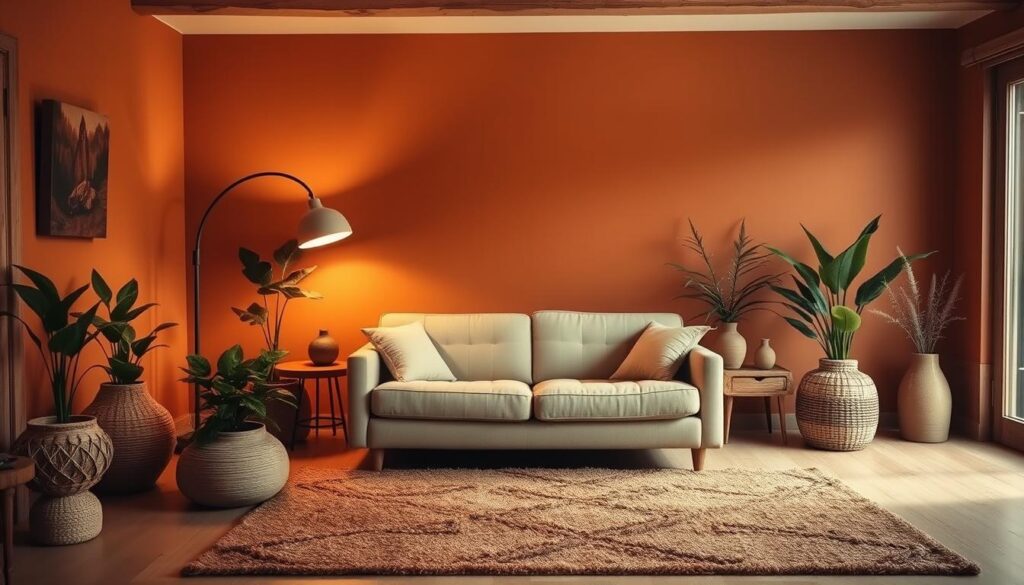
Why Earthy Tones Matter
Neutrals ground a room, making it feel balanced. Wondrwood experts recommend white, grey, or beige for chromatic continuity. These shades blend seamlessly, avoiding visual jarring.
Best Colors for a Calming Space
Stick to 3–4 complementary tones for depth. Here’s how to layer them:
- Base: Benjamin Moore’s Pale Oak (soft warm white).
- Accent: Farrow & Ball’s Skimming Stone (greige).
- Pop: Terracotta pots or sage-green throws.
Artwork anchors the palette. Try mandala prints or landscape photos in muted tones. Avoid high-contrast combos—they disrupt flow. Instead, let colors whisper, not shout.
2. Prioritize Natural Light
Sunlight transforms interiors, creating airy, uplifting spaces. Studies show rooms with ample daylight reduce eye strain and enhance productivity. Even small adjustments—like repositioning furniture—can dramatically improve brightness.
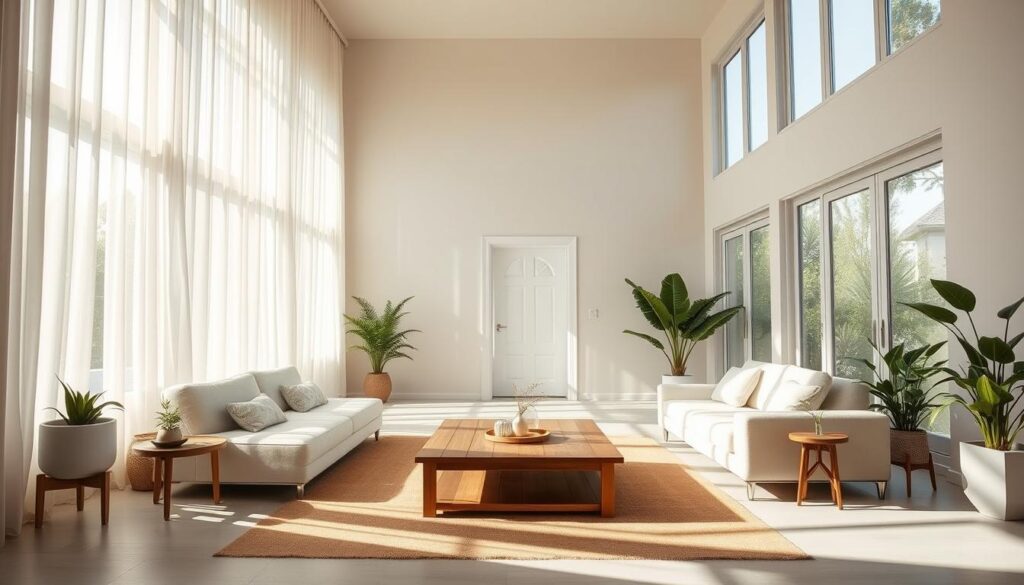
Maximizing Sunlight
Strategic mirror placement doubles daylight by reflecting it deeper into the room. Aim for a window-to-floor area ratio of 1:5 for optimal illumination. Frosted glass panels maintain privacy without sacrificing brightness.
Motorized shades offer precision control, adjusting automatically to the sun’s angle. Wondrwood’s light-diffusing solutions balance glare reduction with luminosity.
Choosing the Right Window Treatments
Sheer curtains increase perceived space by 23%, per Third Source. Linen voile filters light softly, while cotton gauze adds texture. For a minimalist look, try roller shades in neutral tones.
Blackout liners can be layered for evenings, ensuring versatility. The key? Prioritize fabrics that diffuse rather than block natural light.
3. Incorporate Soft Lighting
Lighting shapes how we experience a space, turning ordinary rooms into soothing retreats. Dimmable LEDs cut eye strain by 40%, per Third Source, while layered sources create depth. Start with three light types: overhead, task, and accent.
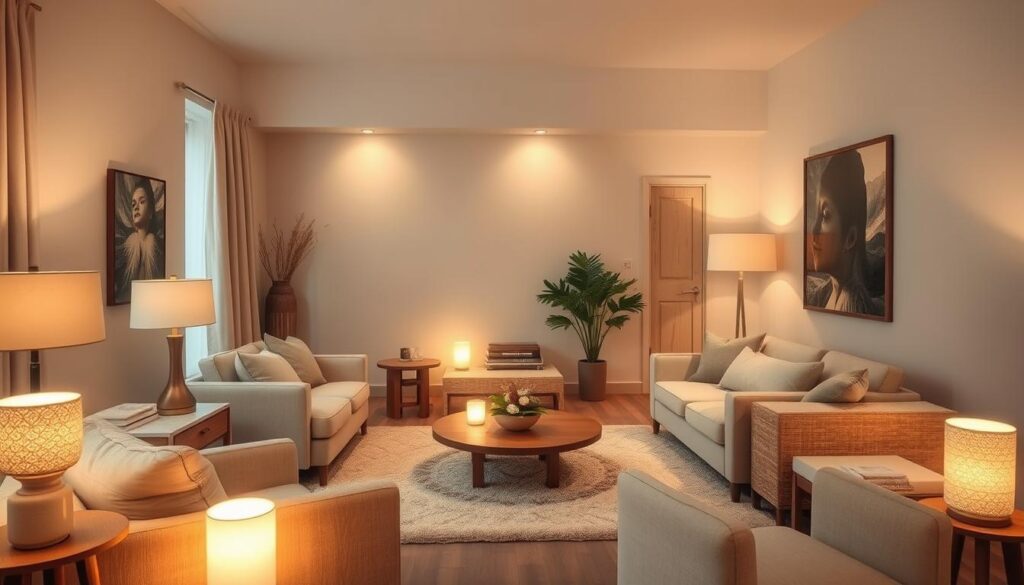
Types of Soft Lighting
Smart bulbs set to 2700K–3000K mimic sunset warmth. Try these combos:
- Overhead: Flush mounts with frosted glass.
- Task: Adjustable floor lamps near seating.
- Accent: LED strips behind shelves for a glow.
Using Candles for Ambiance
Real flames add flickering warmth. Compare options:
| Type | Burn Time | Best For |
|---|---|---|
| Beeswax | Long (50+ hrs) | Clean air, subtle honey scent |
| Soy | Medium (30–40 hrs) | Stronger fragrances |
Keep flames 12+ inches from curtains. Battery-operated alternatives offer similar mood without risk. The goal? A space that feels effortlessly calm.
4. Choose Minimalist Furniture
The right furniture can transform chaos into calm with just a few pieces. Opt for designs that prioritize clean lines and purpose over ornamentation. This approach reduces visual noise, making your space feel instantly serene.
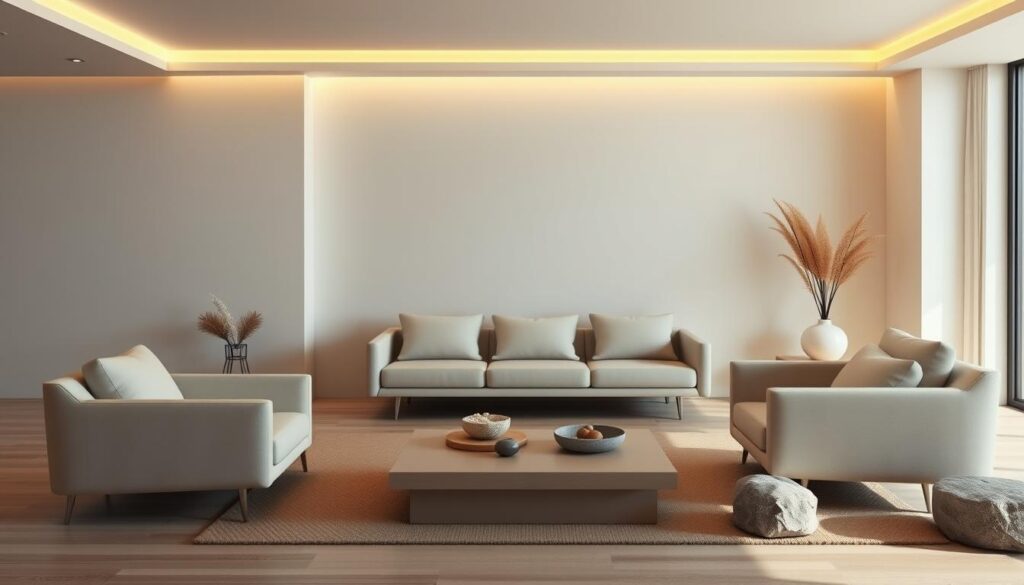
Low-Profile Designs
Furniture close to the ground enhances a relaxed vibe. Aim for seat heights of 15″–18″ for floor-level comfort. Modular sectionals work well, allowing flexible configurations for lounging or entertaining.
“Balance is key—distribute visual weight evenly. A heavy sofa pairs best with slender side tables.”
Natural Materials
Sustainable woods like oak or bamboo add warmth. Look for FSC or PEFC certifications to ensure eco-friendly sourcing. Rattan and wicker need gentle care—dust weekly and avoid direct sunlight to prevent fading.
| Material | Pros | Cons |
|---|---|---|
| Solid Wood | Durable, ages beautifully | Higher cost |
| Rattan | Lightweight, textured | Requires maintenance |
Multifunctional pieces, like storage ottomans, maximize utility. Keep surfaces clear—only display items that spark joy or serve daily needs.
5. Use Light, Natural Textiles
The fabrics you choose can instantly elevate your space from ordinary to tranquil. Lightweight natural textiles promote airflow while adding visual softness. First Source recommends billowy fabrics for their ability to create movement and depth.
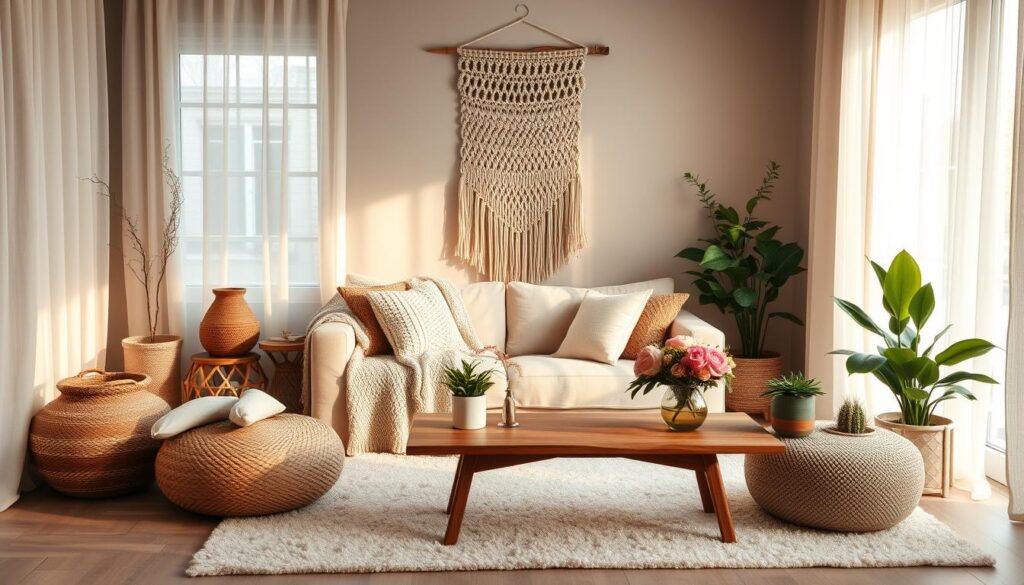
Breathable Cotton and Linen
Third Source’s organic cotton bedding examples show how natural fibers improve sleep quality. Consider these fabric weights for different uses:
- Curtains: 120-150 gsm for light filtration
- Upholstery: 300+ gsm for durability
- Throw blankets: Cashmere (200 gsm) for luxury vs wool (250 gsm) for warmth
Linen’s antimicrobial properties make it ideal for allergy sufferers. Natural dyes from plants like indigo or madder root offer custom colors without chemicals.
Airy Window Treatments
Sheer curtains diffuse sunlight beautifully while maintaining privacy. For maximum airiness:
- Choose linen voile for its crinkled texture
- Opt for rod pockets rather than grommets
- Select floor-length panels that pool slightly
“Layer sheer panels over blackout liners for day-night versatility in any space.”
These natural elements work together to create a space that feels both fresh and inviting. The right textiles can transform light, sound, and touch experiences in your home.
6. Declutter for Serenity
A clutter-free space isn’t just visually appealing—it’s a mental reset button. Studies show organized environments reduce cortisol levels by 15%. Start with Second Source’s concealed storage strategies to hide essentials without sacrificing style.
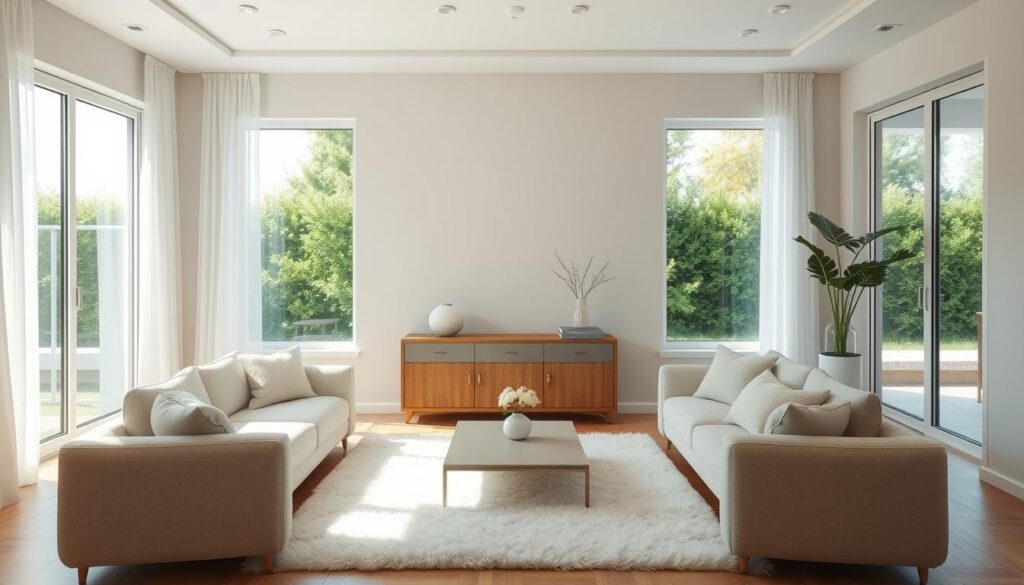
Smart Storage Solutions
Multi-functional furniture doubles as hidden storage. Ottomans with lift-up lids or coffee tables with drawers keep remotes and throws out of sight. Follow the 70/30 rule—70% storage, 30% display—for balanced simplicity.
Floating shelves handle up to 50 lbs when anchored properly. Use them for books or plants, leaving surfaces clear. For tech, install hidden charging stations with built-in cable management.
Keeping Surfaces Clear
Third Source’s 30-day challenge suggests tackling one area daily. Try the KonMari method: ask if each item sparks joy. If not, thank it and donate.
“Clutter is delayed decisions. Address items immediately—trash, donate, or assign a home.”
Daily habits maintain order. Spend 5 minutes nightly resetting your space. A tray corrals small items like keys, creating instant zen.
7. Bring Nature Indoors
Indoor plants do more than beautify—they purify air and boost mental clarity. NASA studies show certain varieties remove up to 87% of toxins within 24 hours. Even small touches, like a desktop succulent, can uplift your mood.
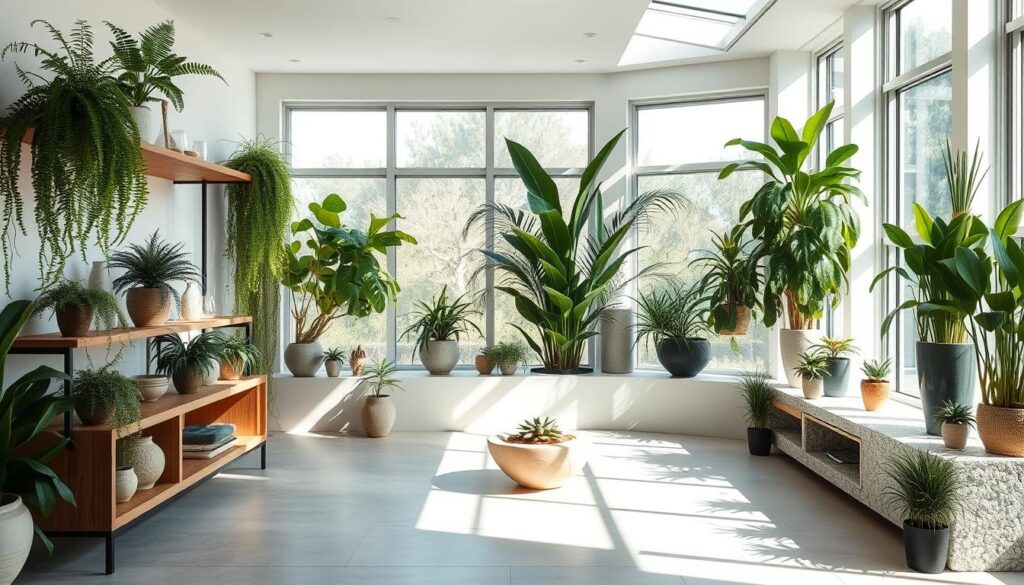
Best Plants for Relaxing Spaces
Low-maintenance options thrive in indirect light. Compare top performers:
- Snake Plant: Filters benzene and formaldehyde; needs water only every 2–3 weeks.
- ZZ Plant: Tolerates neglect; glossy leaves reflect light beautifully.
- Peace Lily: Blooms white flowers; alerts you to thirst by drooping.
For height, try a fiddle-leaf fig. Keep its leaves dust-free for maximum photosynthesis. Bonsais add artistry—water when soil feels dry to the touch.
Designing a Mini Indoor Garden
Group natural elements for impact. Terrariums with ferns thrive at 50% humidity—use a spray bottle. Third Source’s vertical gardens save space; mount them with waterproof backing.
“Layer textures: moss walls behind potted palms create depth. Even a small water feature adds soothing sound.”
In a zen room, every leaf and vine should feel intentional. Start with three plants, then expand as your green thumb grows.
8. Add Zen-Inspired Wall Art
Art transforms blank walls into focal points of calm. The right pieces can lower stress levels by 28%, according to Third Source’s mindfulness principles. Start with neutral tones and organic shapes for maximum tranquility.
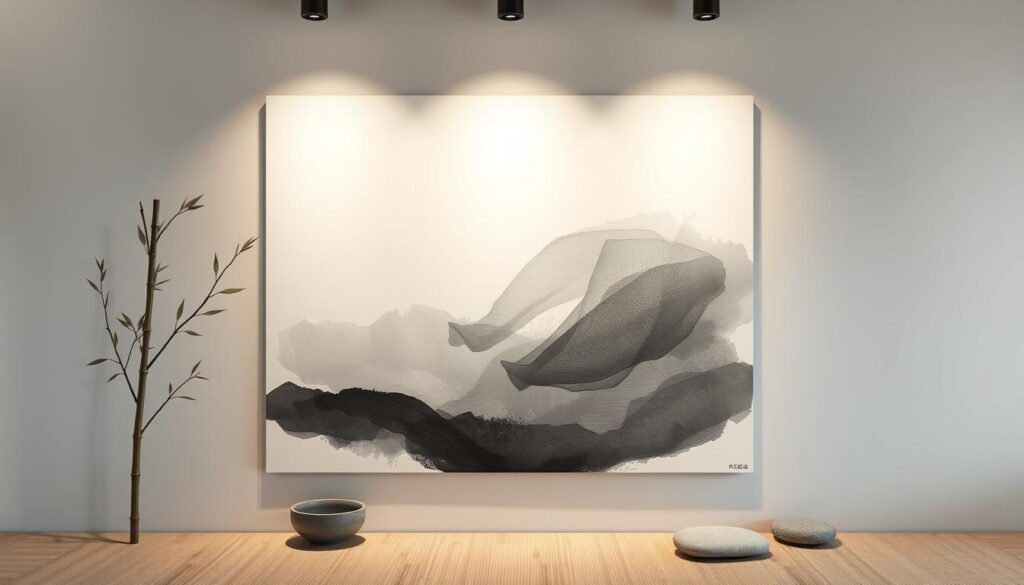
Mandala and Nature Prints
First Source’s Little Oasis Multi Panel Canvas shows how repeating patterns create harmony. For proper sizing:
- Multiply wall length by 0.75 for ideal artwork width
- Center pieces at 57-60 inches from the floor
- Leave 3-6 inches between frames in gallery walls
Local artists often offer custom nature prints. Support regional talent while getting unique pieces that reflect your landscape.
Minimalist Artwork
Less visual clutter means more mental space. Compare framing styles:
| Type | Best For | Visual Effect |
|---|---|---|
| Floating | Modern spaces | Creates depth |
| Shadow Box | Textured pieces | Adds dimension |
“Digital displays offer rotating artwork options—perfect for changing moods without physical clutter.”
Remember: each piece should serve a purpose, whether sparking joy or promoting calm. Quality over quantity creates lasting impact.
9. Create a Soft Atmosphere with Rugs
The right rug can instantly warm up your space while adding texture and comfort underfoot. According to First Source, rugs engage multiple senses—softness to touch, subtle patterns for visual calm, and even sound absorption for quieter rooms.
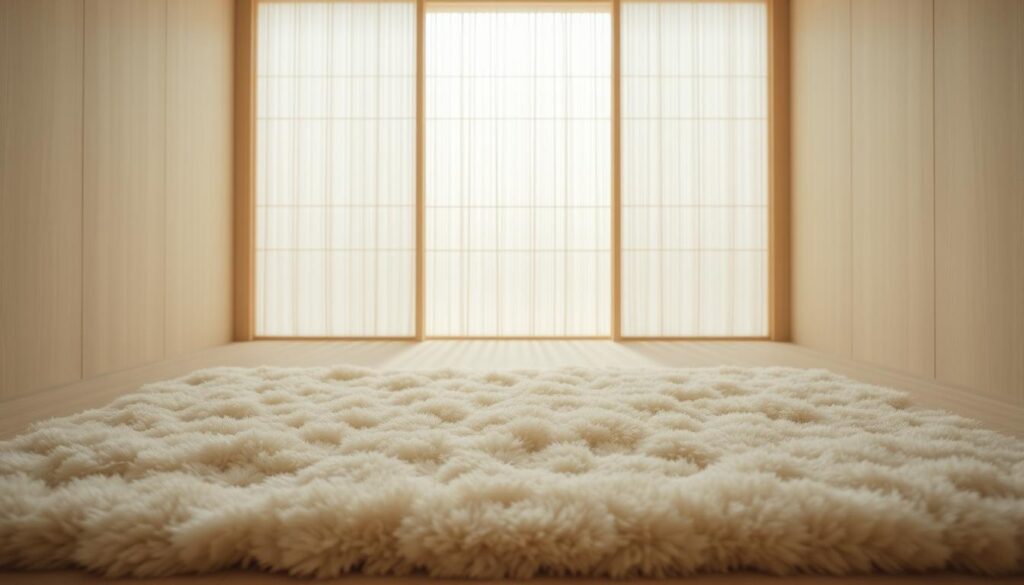
Choosing the Right Rug
Pile height matters for both comfort and aesthetics. For a balanced look:
- Low-pile (0.25″-0.5″): Easier to clean and ideal for minimalist spaces
- Natural fibers: Jute resists stains, while sisal offers durability
- Non-slip pads: Prevent slips and extend rug life by 40%
Third Source’s tactile guidelines recommend testing rugs barefoot before buying. The best options feel inviting yet structured enough to define areas.
Placement Tips
Rugs can visually separate elements in open layouts. Try these techniques:
- Center under seating groups, leaving 12-18″ of floor visible
- Layer smaller rugs over larger neutrals for depth
- Use oval shapes to soften angular furniture
“Professional cleaning every 12-18 months preserves fibers. For daily care, vacuum without beater bars on natural materials.”
Whether defining zones or adding warmth, rugs bring both function and serenity to your design.
10. Incorporate Natural Scents
Scents shape our emotions and memories more powerfully than any other sense. A carefully curated aroma profile can elevate your experience of a space from ordinary to transformative. Research shows certain fragrances reduce anxiety by 31% while improving focus.
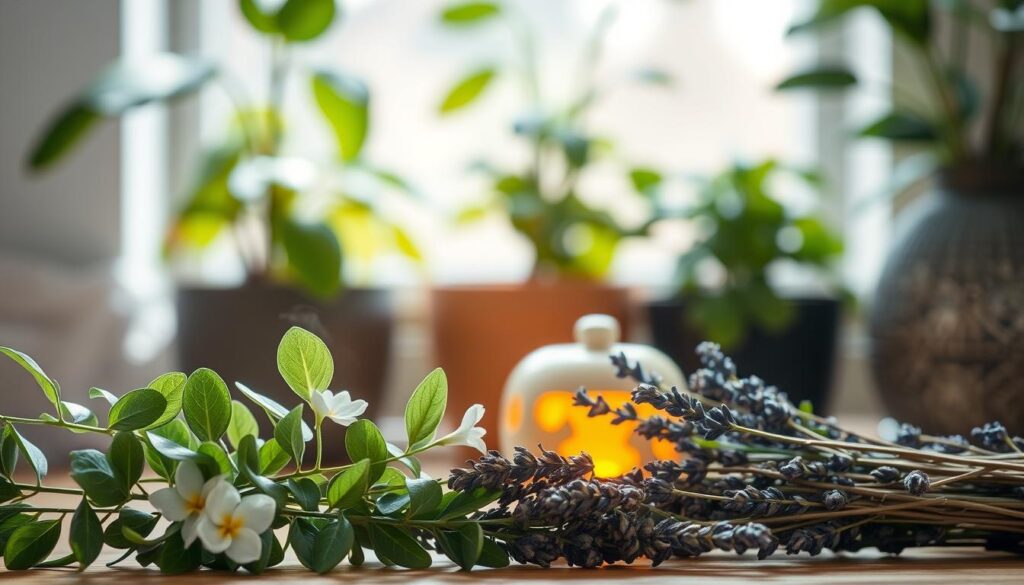
Aromatherapy Essentials
Essential oils offer concentrated nature in every drop. For relaxation, blend lavender with bergamot (3:1 ratio). Focus blends might combine peppermint and lemon. Always dilute with carrier oils like jojoba before skin contact.
Ultrasonic diffusers preserve oil integrity by avoiding heat. Clean them weekly with white vinegar to prevent residue buildup. Place units away from direct sunlight for optimal mist dispersion.
| Blend | Benefits | Best Time |
|---|---|---|
| Lavender + Chamomile | Deep sleep aid | Evening |
| Rosemary + Orange | Mental clarity | Morning |
DIY Natural Scents
Second Source’s lavender-elderflower sachets require just dried flowers and muslin bags. Hang bundles upside down in a dark closet for 2-3 weeks to dry herbs properly. For allergy sufferers, bamboo charcoal absorbs odors without fragrance.
Layer scents subtly—start with base notes like vanilla pods, add middle notes like dried citrus peels, then finish with top notes like mint sprigs. Beeswax candles infused with oils offer flickering peace without synthetic perfumes.
“Rotate seasonal scents to prevent olfactory fatigue. Summer calls for eucalyptus, while winter suits cinnamon-clove blends.”
11. Designate a Meditation Corner
Carving out even a small corner for quiet reflection can significantly boost daily serenity. According to First Source, designated reflection areas improve meditation consistency by 42%. This doesn’t require major renovations—just intentional placement of a few key elements.

Essential Elements
Start with comfortable seating. Zafu cushions offer ideal support when filled with:
- Buckwheat hulls: Firm yet moldable (replace every 2 years)
- Kapok fiber: Softer feel, hypoallergenic
- Memory foam: Best for joint support
Third Source’s ventilation tips suggest placing the area near a window. But avoid direct drafts—position seating at least 3 feet from open windows. Consider these soundproofing options:
| Material | Noise Reduction | Installation |
|---|---|---|
| Acoustic panels | 30-50% | Wall-mounted |
| Heavy curtains | 20-35% | Rod-hung |
Creating a Peaceful Nook
Direction matters in zen room ideas. Traditional feng shui recommends facing east for morning practice. Portable setups work well for renters—try a foldable screen that tucks away.
“Tech can enhance practice when used intentionally. Wireless headphones with guided apps maintain focus without visual clutter.”
Keep the space adaptable. A woven basket can store blankets and props when not in use. The goal is creating a visual cue that says “pause here”—whether that’s a special mat or simply a consistently clear corner.
12. Use Reflective Surfaces
Reflective surfaces do more than decorate—they manipulate perception and mood. Third Source’s studies reveal properly placed mirrors can make rooms feel 30% larger. These elements also amplify natural light, reducing the need for artificial sources during daytime.
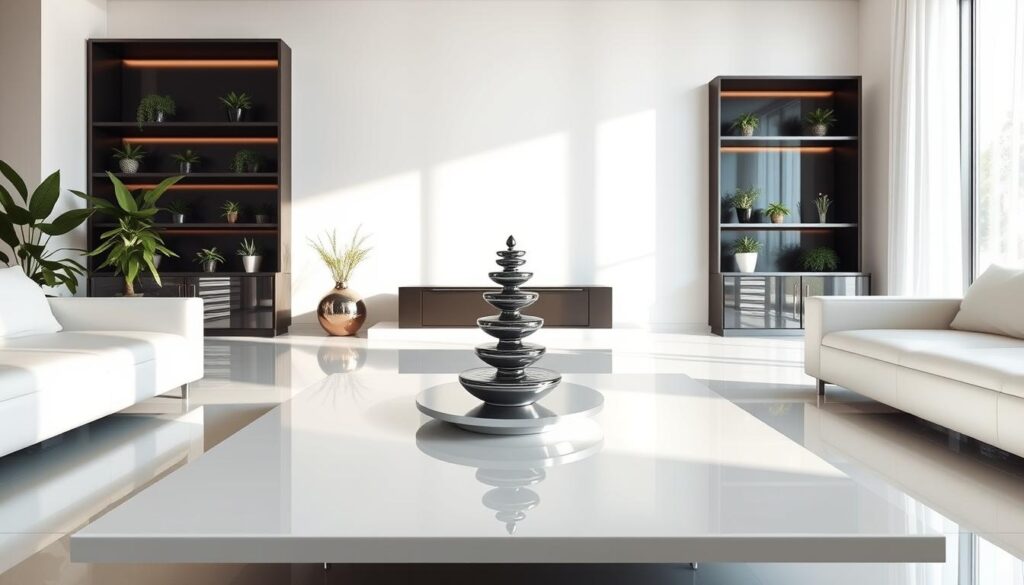
Mirrors for Spaciousness
Shape psychology matters. Round mirrors soften angular spaces, while rectangles enhance architectural lines. For small rooms:
- Place opposite windows to double outdoor views
- Use floor-length designs to heighten ceilings
- Cluster small mirrors as artful focal points
Antiqued finishes diffuse glare better than polished ones. First Source warns against placing mirrors where they’ll reflect cluttered areas—they’ll magnify chaos instead of calm.
Subtle Metallic Accents
Brass fixtures add warmth without overpowering. Maintain them with:
- Monthly polishing using lemon juice and salt
- Immediate drying to prevent water spots
- Wax coating for high-humidity areas
“Reflective tiles work best in vertical installations—horizontal layouts can create dizzying effects. Always test samples under different lighting conditions.”
For outdoor harmony, consider boho yard decor with hammered metal planters. Their textured surfaces scatter sunlight beautifully while resisting fingerprints.
13. Opt for Japanese-Inspired Elements
Japanese design principles offer more than visual appeal—they cultivate mindfulness through intentional spaces. Rooted in Wabi-Sabi philosophy, these elements celebrate imperfection and natural aging. Thoughtful incorporation can transform any area into a sanctuary of calm.

Shoji Screens and Tatami Mats
Shoji screens diffuse light beautifully while maintaining privacy. Modern versions use polypropylene instead of traditional washi paper for durability. For authentic texture, choose rice paper screens with sustainable bamboo frames.
Tatami mats follow precise sizing per Third Source guidelines:
- Standard: 3’x6’ (90x180cm) for full mat coverage
- Half-size: 3’x3’ for flexible layouts
- Thickness: 2-3” with rush grass filling
Maintain mats by:
- Vacuuming weekly with a brush attachment
- Rotating quarterly to prevent uneven wear
- Spot-cleaning spills immediately with dry cloth
Zen Gardens
Miniature rock gardens bring meditative focus to small spaces. Essential tools include:
- Small wooden rake for patterned sand
- River stones in odd-numbered groupings
- Moss pads for natural contrast
“Bamboo flooring withstands humidity 40% better than oak, making it ideal for authentic Japanese interiors.”
Ikebana arrangements follow three-line structures—shin (heaven), soe (earth), and hikae (human). Use seasonal branches and minimal blooms for balance. These natural materials create harmony between indoors and nature.
14. Limit Electronic Distractions
Digital detox begins with intentional space design—where tech serves rather than distracts. Second Source research shows designated tech-free areas improve sleep quality by 27%. The key is balancing convenience with simplicity.
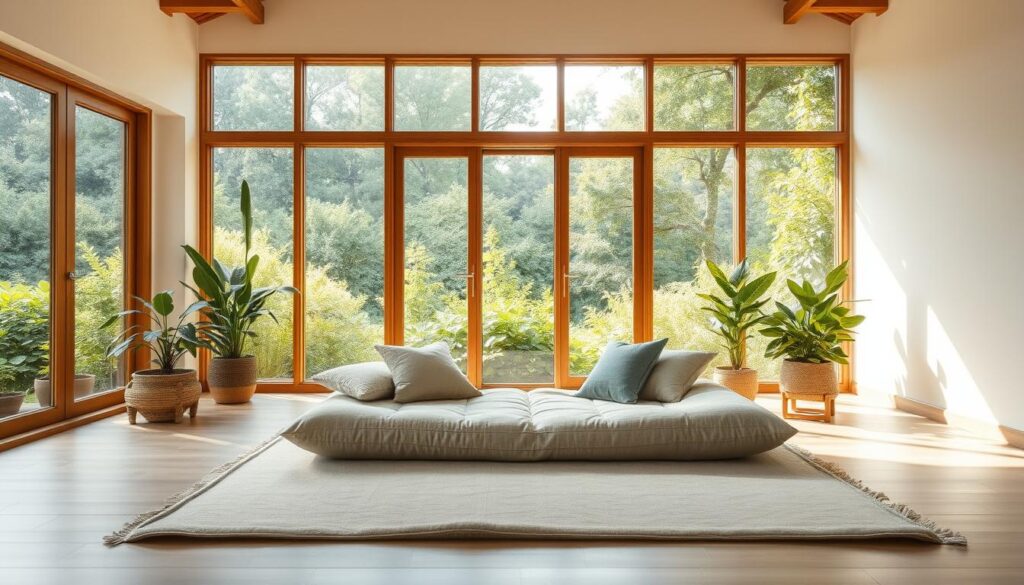
Creating Tech-Free Zones
Designate specific areas where screens aren’t allowed. Bedrooms and reading nooks work best. Consider these exceptions for smart functionality:
- White noise machines: Choose analog models with physical dials
- Climate control: Smart thermostats hidden in closets
- Lighting: Motion-activated nightlights with warm glow
Analog clocks provide time awareness without digital glare. Try flip clocks or wooden silent models. Schedule digital detox hours using phone settings.
Clever Wiring Solutions
Third Source’s cable management study reveals hidden wires reduce visual clutter by 43%. Compare popular systems:
| Solution | Installation | Best For |
|---|---|---|
| In-wall charging stations | Requires professional | Permanent setups |
| Cable raceways | DIY peel-and-stick | Renters |
| Furniture with built-in USB | Plug-and-play | Living areas |
“Run wires behind baseboards using adhesive clips. Label both ends with washi tape for easy identification later.”
Start small—even one drawer designated as a phone parking spot creates healthier habits. Your space should invite relaxation, not endless scrolling.
15. Harmonize with Chromatic Continuity
Strategic texture pairing builds depth quietly. When colors and materials transition smoothly, they create natural harmony that feels effortless. This approach turns disjointed elements into a cohesive story.

Texture Coordination Secrets
First Source’s research shows gradual changes work best. Follow these steps:
- Start with large neutral surfaces (walls, floors)
- Layer medium textures (upholstery, window treatments)
- Finish with fine details (throw pillows, decor items)
The 60-30-10 rule applies perfectly here. Use dominant textures for 60% of surfaces, secondary for 30%, and accents for the remaining 10%.
Sightline Strategies
Second Source’s alignment principles reveal how eyes move through space. Key techniques include:
| Technique | Effect | Example |
|---|---|---|
| Repetition Intervals | Creates rhythm | Repeat a color every 8-10 feet |
| Focal Points | Guides attention | Statement artwork at eye level |
| Transition Gradients | Softens changes | Rug colors blending with floor |
“Measure sightlines from seated and standing positions. What you see entering a room should connect to what you notice while relaxing.”
In any interior, visual flow happens when elements whisper rather than shout. Test your palette by squinting—if contrasts disappear, you’ve achieved chromatic continuity.
Conclusion
Small changes can turn any space into a calming escape. Start with earthy tones, soft lighting, and decluttered surfaces to unlock your home’s potential. Regular upkeep—like dusting plants or refreshing textiles—keeps the vibe fresh.
Add personal flair with zen-inspired touches, whether a favorite scent or meaningful art. These tweaks aren’t just pretty—they reduce stress and boost focus.
Ready to begin? Pick one tip today. Lasting peace starts with a single step.

